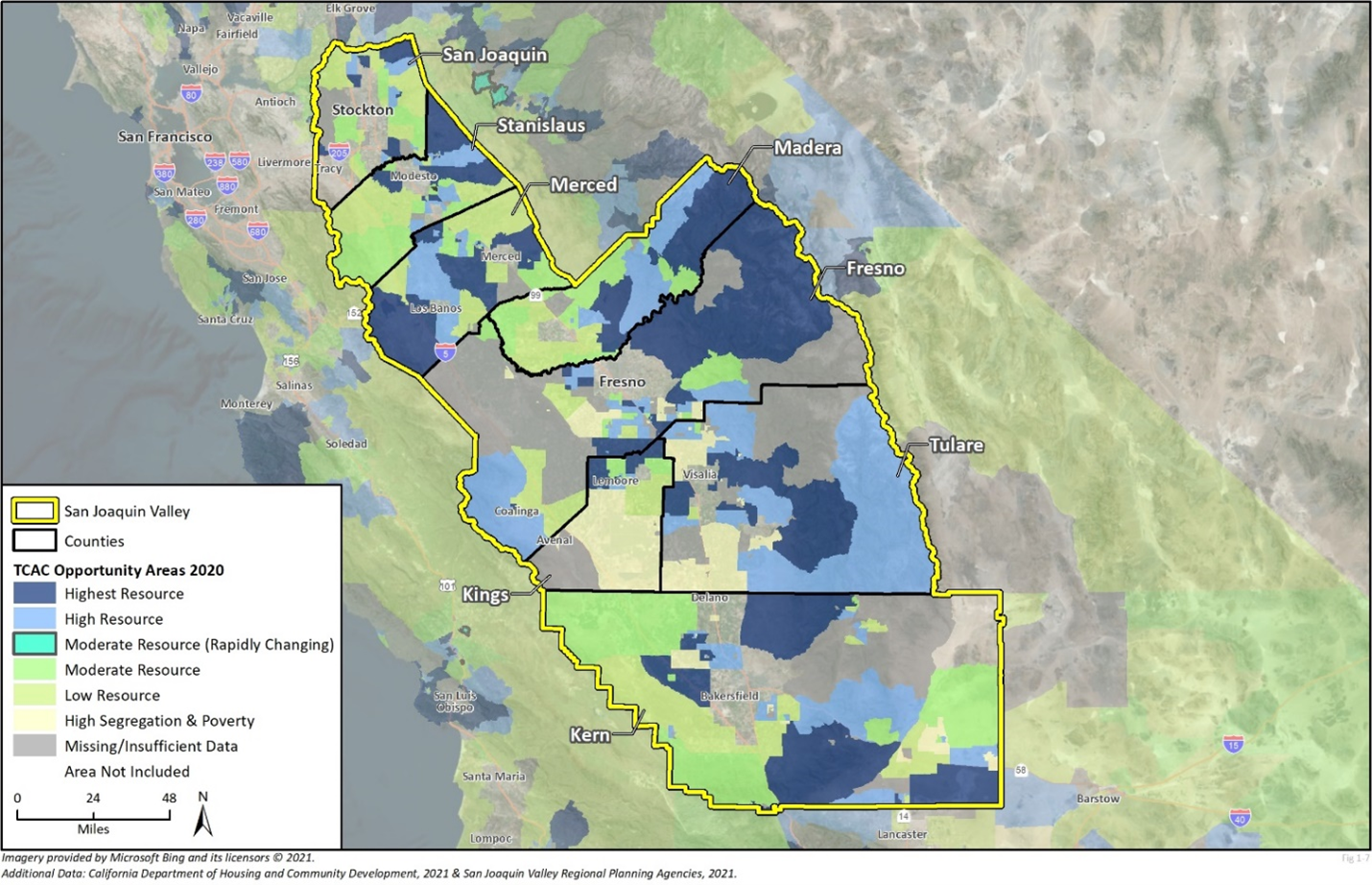Access to opportunity correlates housing location with opportunity or resources. Residents should have equal access to essential public and private resources, including education, employment, safe and decent housing, transportation, recreation, food, and a healthy environment. Opportunity disparities are inequalities in resources and quality of life, depending on location, race, ethnicity, and other defining factors.
As part of California’s effort to affirmatively further fair housing (AFFH), the State requires all public agencies to include an analysis of local disparities in accessing opportunity as part of their fair housing assessment. To appropriately address this requirement, public agencies should graphically and narratively assess historic and current trends in resource access by analyzing the relationship between local geography and available resources, as well as the relationship between race/ethnicity and available resources. Resources analyzed should include access to public transit options, educational opportunities, employment and proximity to jobs, and access to a healthy environment. By effectively analyzing opportunity disparities within the fair housing assessment, public agencies can appropriately inform fair housing policies and actions within their housing elements.
Relevant State Law
Assembly Bill 686 (AB 686) expands fair housing requirements and protections outlined in the California Fair Employment and Housing Act (FEHA). AB 686 requires that public agencies affirmatively further fair housing by assessing the housing context within their jurisdictions and making effective policy and program changes to mitigate issues. The law mandates incorporating fair housing assessments into the housing element beginning January 1, 2021. The fair housing analysis must consider available Federal, State, and local data to address a variety of factors, including:
- Integration and segregation
- Racially or ethnically concentrated areas of poverty
- Disparities in access to opportunity, including for persons with disabilities
- Disproportionate housing needs, including displacement risk
As part of this requirement, AB 686 requires developing or modifying programs and policies to promote fair housing opportunities. Additionally, all public agencies must administer programs and activities relating to housing and community development to be consistent with AFFH. These policies and programs must then be supported by identifying metrics or quantifiable objects for determining what fair housing results will be achieved.
Relevance to Housing in the San Joaquin Valley
Access to opportunity varies significantly by geographic location and community characteristics. According to the Urban Institute, neighborhoods in metropolitan areas are more likely to offer residents better access to affordable transportation and stable labor markets compared to rural neighborhoods. In contrast, rural neighborhoods tend to have superior environmental health. The disparities in environmental health, access to affordable transportation, and stable labor markets between urban and rural locations are compounded by the relationship between geographic location and identity characteristics, such as race, ethnicity, and income.
Nationally, racial disparities in accessing opportunity are statistically evident. The Urban Institute identifies that White and Asian/Pacific Islander residents tend to live in neighborhoods with stronger labor markets and higher performing schools in comparison to Black, Hispanic, and Native American residents. These access patterns are likely to be evident in many communities across the United States.
HCD and the California Tax Credit Allocation Committee (TCAC) maintain a joint task force focused on mapping areas at the census tract level with high opportunity-based outcomes for low-income families. These include positive economic, education, and health outcomes. Those identified areas are known as TCAC Opportunity Areas. The figure below depicts an example image of the TCAC Opportunity Areas and their associated resource levels for the San Joaquin Valley. 
Because the TCAC tool maps data at the census tract level, information for areas where data is lacking, or where populated areas are part of a large census tract, may require a more detailed analysis. Each jurisdiction should explore the TCAC tool individually and perform an assessment of local opportunity areas.
These ‘low resource’ areas tend to be predominantly Hispanic/Latino concentrations within the region. In contrast, there is a notable ‘high resource’ trend for communities with predominantly White populations in the San Joaquin Valley, which illustrates the mapping correlation to Census Data racial/ethnic make-up. These resource patterns indicate that there may be significant racial disparities in accessing opportunity within the region. Public agencies should use the TCAC/HCD Opportunity Map to identify local patterns specific to their jurisdictions. These patterns can then be used to develop equitable housing policy to mitigate opportunity disparities and further promote fair housing.
Resources
Association of Bay Area Governments, Data Tools and HESS.
California Department of Housing and Community Development, Affirmatively Furthering Fair Housing In California.
California Department of Housing and Community Development, AFFH Data and Mapping Resources.
Urban Institute, Place and Opportunity (2018).
U.S. Department of Housing and Urban Development, Office of Policy Development and Research, Breaking Down Barriers: Housing, Neighborhoods, and Schools of Opportunity (April. 2016).
